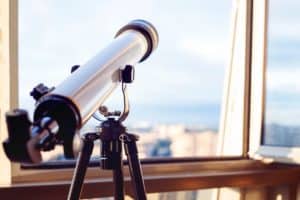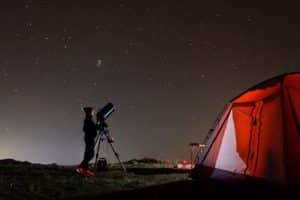Have you ever been to a star party with your local astronomy club? If so, you might have noticed a curious thing: Dobsonian telescopes are incredibly popular! And the reason is pretty simple: Dollar-for-dollar, you get more aperture (and thus more light collection) with a Dobsonian due to its use of relatively lower cost components. In fact, the Dobsonian telescope design is often credited with making amateur astronomy accessible to the general public. In this article we’ll share with you our top 8 picks for the best dobsonian telescope in 2022.
See also:
(Before we begin, please note that product pricing, price categories and availability are accurate as of the date of this post, but are subject to change. This post represents the author’s opinion, based on research and experience, of the “best” or “top” telescopes in this category; the opinions of others may vary.)
Why Your First Telescope Should Be a Dobsonian
If you’re looking for a first telescope, we would strongly recommend you at least consider starting with a Dobsonian.
But why? Well, two simple reasons.
First, Dobsonian telescopes are famously affordable. As a beginner, you can get a 6 inch or 8 inch Dobsonian telescope for under $500 (or so). A larger aperture means more light collection ability. You’ll be able to get wonderful views of the moon, Saturn’s rings, and the bands of Jupiter (plus its moons). But not only that, with a larger aperture you’ll start to be able to see fainter, more distant objects in the night sky. (Like the Orion nebula, Pleiades star cluster, Andromeda galaxy, and other deep sky objects.)
Second, Dobsonian telescopes are super easy to use. The base sits on the ground and you don’t need to bother with various knobs and slow-motion controls to point the telescope where you want to look. Portability is typically good because the telescope easily separates from the mount and goes into your vehicle. With a Dobsonian, you’ll spend more of your time learning your way around the night sky and viewing the dazzling sights, instead of fiddling with your telescope.
Also – another important thing to say up front – Dobsonian telescopes are not just for beginners. At higher price points you can get a 10 inch or 12 inch (or even larger) telescope that will bring the universe to life before your eyes. And some of these are still reasonably portable with a collapsible truss tube design, so you can take them with you camping or to a dark-sky location.
Our Take on the Best Dobsonian Telescope (Top 8 Recommendations for 2022) | Part One – Up to 8″
Many would say that 6″ to 8″ aperture is the “sweet spot” for an amateur telescope. On one hand, this is large enough to provide stunningly detailed images of objects within the solar system, while also enabling you to get glimpses of deep-sky targets that are much harder to see with smaller telescopes.
On the other hand, these telescopes are still transportable and affordable for the average enthusiast – so it’s a telescope that will get a lot of use. If you go much smaller, you won’t have quite the same experience of wonder; if you go much bigger, your telescope may end up collecting dust in a closet.
1. Orion 8945 SkyQuest XT8 Classic Dobsonian Telescope
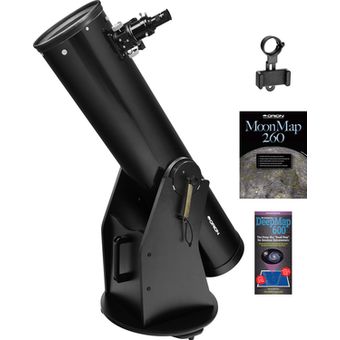
Image Credit: Orion (Used with Permission)
Our overall top pick for best Dobsonian telescope. The Orion SkyQuest XT8 is our #1 “all around” Dobsonian recommendation. It’s versatile and affordable, with a powerful 8″ (203mm) primary mirror, while still being portable enough to fit in your vehicle. (In fact, this telescope is my own personal favorite recommendation for amateur backyard and dark-sky location viewing.) True to the classic Dobsonian design, it’s a Newtonian reflector with a friction-based alt-azimuth mount. It’s easy to use, and makes for a perfect “grab and go” telescope. You will be hard-pressed to find a telescope that offers more bang for the buck.
Scorecard – Orion 8945 SkyQuest XT8 Classic Dobsonian Telescope
| Category | Our Verdict | Why? |
|---|---|---|
| Skill Level | Beginner to Intermediate | Good for beginners; can grow with you |
| Quality | 4 out of 5 | Good component quality |
| Ease of Use | 4 out of 5 | Easy to locate targets; collimation required |
| Power & Clarity | 5 out of 5 | 8" primary mirror for amazing views! |
| Control | 4 out of 5 | Dobsonian mount is easy to use but requires manual tracking |
| Portability | 3 out of 5 | Transportable, but not ultra-portable |
| Accessories | 3 out of 5 | Good quality accessories, but you will probably want to add more eyepieces |
| Overall Value | 5 out of 5 | Great value for excellent images! |
Why This is Our Top Recommendation
First, the 8″ mirror is a great place to start. It’s small enough to still be transportable, so you can take it with you camping or to your favorite dark-sky spot. (Or you can easily set it up in your backyard, and just as easily bring it back inside for storage.) However, at 8″ it provides enough light-gathering capability to give your telescope some “reach”.
With this amount of power, you can get up close and personal with anything in the solar system. Or, you can go beyond our little corner of the universe and get some wonderful views of more distant galaxies, star clusters, nebulae. The focal length (1200mm) gives you a high theoretical magnification of 300x, so you can zoom in close on anything you want to see. (Depending of course on which eyepiece you use.) The optical quality is excellent, with a true parabolic mirror and enhanced-reflectivity mirror coatings (94% reflectivity).
Second, we think the XT8 is a great choice for anyone who wants to really learn how to navigate the night-time sky. The mounting system makes it easy to point the telescope in any direction (even for kids). Thanks to Orion’s “CorrecTension” system (heavy-duty springs and friction pads), the telescope will stay balanced and stable until you need to point it at a new target.
Bottom line: This telescope is just super practical for the amateur astronomer or hobbyist. The size and weight is in the “sweet spot” – it provides excellent optical power without being too big and cumbersome to use. Additionally, it easily separates into 2 pieces (about 20 lbs. each) so you can take it with you into the field. We also love the fact that this telescope accepts both 1.25″ and 2″ eyepieces – giving you a bit more flexibility and viewing options.
Included Accessories
The standard SkyQuest XT8 comes with a single 2″ Crayford focuser, a 25mm Sirius Plossl eyepiece (for 48x magnification), an EZ Finder II reflex sight, collimation cap, Starry Night software download, and more.
Pros
- 8″ primary mirror lets you view fainter, deep space objects
- Dobsonian base is easy to point and go
- Excellent overall value and versatility
- Accepts 1.25″ and 2″ eyepieces!
Cons
- Accessories are somewhat basic (for example, only one eyepiece included) – but keep reading for some options to consider
- Somewhat heavy (40 lbs. total) but still portable
If Your Budget is a Little Higher, Check Out the SkyQuest XT8 Plus
While the classic SkyQuest XT8 comes with somewhat basic accessories, Orion also sells a “Plus” version with some nice upgrades and a better accessories package.
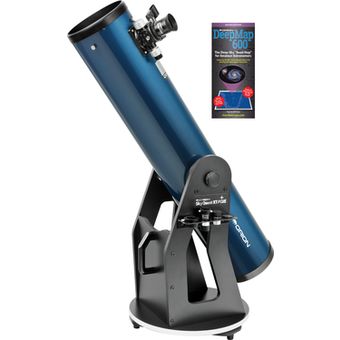
Image Credit: Orion (Used with Permission)
The SkyQuest XT8 Plus (See it on Telescope.com or See it on Amazon.com) includes the following upgrades:
- Metallic blue finish
- Redesigned base with altitude tension knobs (improves stability when using heavier 2″ eyepieces)
- Thumbscrew adjustable secondary mirror (for easier collimation)
- Dual speed 11:1 Crayford focuser (so you can fine-tune the focus more easily)
- Comes with two eyepieces: a 2″ 28mm DeepView eyepiece and a 1.25″ 10mm Sirius Plossl eyepiece
- Shorty 2x Barlow lens
- Eyepiece rack
- DeepMap 600 Folding Star Chart
- Lighter weight
Other Recommended Accessories
Click here to expand- If you want to be able to discern fine details on the moon’s surface, you might want to add a moon filter. Without it, the moon will be intensely bright because the XT8’s mirror is so powerful. We recommend Orion’s 13-percent transmission moon filter:
- A 6.3 mm eyepiece provides 190x magnification with the XT8 – perfect for getting detailed lunar and planetary images. Here’s a kit from Orion that includes a variety of 1.25″ eyepiece upgrades, including a 6.3mm plus a moon filter and more:
- You might want to consider adding a 2″ (32 mm) eyepiece – perfect for star-hopping with the XT8. Orion’s Q70 eyepieces are excellent:
2. Zhumell Z130 Portable Altazimuth Reflector Telescope (Tabletop Dobsonian)
Zhumell’s “Tabletop Dobsonian” telescope offers a revolutionary balance between flexibility and affordability, without sacrificing too much power. This 130mm (~5″) telescope from Zhumell doesn’t look quite the same as the classic Dobsonian because its base has a single arm vs. the more classic fork arm. However, the Z130 from Zhumell is a really great option if you’re looking for something more compact and versatile than the classic Dobsonian. With a 5″ aperture it’s still pretty good in terms of optical capability. And it can often be found in the $300 or below price range.
Scorecard – Zhumell Z130 Tabletop Dobsonian
| Category | Our Verdict | Why? |
|---|---|---|
| Skill Level | Beginner | Suitable for beginners |
| Quality | 4 out of 5 | Great component quality |
| Ease of Use | 5 out of 5 | Easy to use tabletop design; requires collimation |
| Power & Clarity | 4 out of 5 | Bright images with 5" primary mirror |
| Control | 4 out of 5 | Easy to point and move to your target |
| Portability | 5 out of 5 | Super compact, easy to setup and move |
| Accessories | 4 out of 5 | Everything needed to get started, includes 2 eyepieces |
| Overall Value | 5 out of 5 | Superb value |
Why We Like It
Zhumell’s Z130 tabletop dobsonian offers the same advantages as a classic Dobsonian in terms of ease-of-use and affordability – while offering a smaller overall package.
This smaller and more compact design is achieved with two things. First, it has a shorter tube length and focal distance. (This gives you a wider field of view and also makes star hopping a little easier.) Second, it features a “tabletop” base which expands your viewing options to include picnic tables and other surfaces. (Tabletop telescopes are also fantastic for kids because they can sit next to the telescope on the table.)
Pros
- Excellent affordability, one of the best values in its price range
- Compact, versatile, tabletop dobsonian design
- Easy to use, easy to move
Cons
- Less powerful than larger dobsonian telescopes
3. Orion 8944 SkyQuest XT6 Classic Dobsonian Telescope
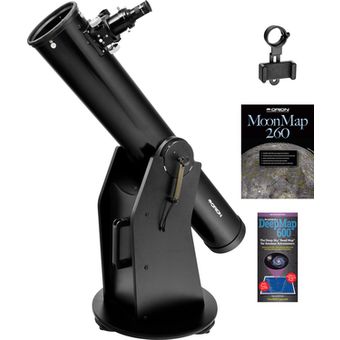
Image Credit: Orion (Used with Permission)
Little brother to the XT8, this Dobsonian telescope features a 6″ (150mm) reflector, with excellent affordability and ease-of-use. If you like the XT8 but you’re on a slightly tighter budget, and still looking for a beginner telescope that will give you many years of viewing pleasure, we recommend this 6 inch Dobsonian from Orion. While the aperture is a little smaller, it also has the advantage of being more portable and lighter for transportation.
With a 6″ aperture you’ll still be able to get wonder-inspiring views within our solar system. You can see the bands of Jupiter, Saturn’s rings, Jupiter’s moons, and intricately detailed images of the moon’s surface features and craters. If you bring it with you to a dark sky location, you’ll still be able to see targets deeper in the sky – just not quite at the same level of detail that’s possible with 8″ or larger.
Scorecard – Orion 8944 SkyQuest XT6 Classic Dobsonian Telescope
| Category | Our Verdict | Why? |
|---|---|---|
| Skill Level | Beginner | Suitable for beginners |
| Quality | 4 out of 5 | Great component quality |
| Ease of Use | 4 out of 5 | Requires collimation but overall ease of use is high |
| Power & Clarity | 4 out of 5 | Wide aperture for bright images |
| Control | 4 out of 5 | Easy to use, requires manual tracking |
| Portability | 3 out of 5 | A little heavy, but still portable |
| Accessories | 3 out of 5 | Just the essentials and one eyepiece |
| Overall Value | 4 out of 5 | Great value |
Why We Like It
Like the XT8, the Orion SkyQuest XT6 is a classic Newtonian reflector telescope. It features a huge 6″ (150mm) primary parabolic mirror with a long focal length (1200mm) – making it the perfect choice for detailed planetary views with a f/8 focal ratio.
Keep in mind, the amount of light collection is related to the square of the diameter, so a 6″ telescope collects nearly 80% more light than a 4.5″ aperture. This is why Dobsonian telescopes are favorites among amateur astronomers – aperture is king!
While magnification out of the box is only 48x (with the included 25mm Sirius Plossl eyepiece), it’s capable of a high theoretical magnification of 300x with separately purchased eyepieces.
The mount is essentially the same as the XT8. You can simply point the telescope by hand where you want to look. It features a low-cost Dobsonian wood base, with non-stick PTFE/Nylon altitude and azimuth pads. Its “CorrecTension” springs keep the tube balanced and provide for smooth, precise movement.
Bottom line: The XT6 is a true “grab and go” telescope. It’s simple to setup, easy to use, reasonably powerful, and sturdy enough to last years.
Included Accessories
One downside of the XT6 (like the XT8) is the accessories are fairly basic. It comes with one 25mm Sirius Plossl eyepiece, so you’ll almost certainly want to purchase additional eyepieces to get maximum usage from the telescope. (But there is also a “XT6 Plus” option, see the recommended accessories below.) It also includes a EZ Finder II finder scope, 1.25″ rack-and-pinion focuser, and Orion’s Starry Night Special Edition software.
Pros
- Reasonably powerful 150mm (6″) aperture
- Sturdy, affordable Dobsonian construction
- Long focal length is ideal for zooming in on planetary details
- Easy to carry and setup
Cons
- Still a little heavy at 34.4 lbs. fully assembled, but you can still fit it easily in a vehicle
- Only one eyepiece included
Recommended Accessories
Click here to expand- If your budget is just a little higher, you might want to check out the “XT6 Plus” which includes a few additional upgrades compared to the XT6: See it on Telescope.com or See it on Amazon.com
- Adding more eyepieces will enhance the versatility of your viewing options with the XT6. Here’s a kit from Orion that includes a variety of 1.25″ eyepiece upgrades, including a 6.3mm (for high magnification) plus a moon filter and more:
4. Sky-Watcher Classic 200P Traditional 8 Inch Dobsonian
Another fantastic 8″ dobsonian option. This 8″ offering from Sky-Watcher is a close competitor to the Orion XT8. It comes with an extra eyepiece compared to the XT8, and a slightly different Alt-Az tension design, but similar overall value and performance.
Scorecard – Sky-Watcher Classic 200P Traditional 8″ Dobsonian
| Category | Our Verdict | Why? |
|---|---|---|
| Skill Level | Beginner to Intermediate | Good for beginners; can grow with you |
| Quality | 4 out of 5 | Good component quality |
| Ease of Use | 4 out of 5 | Easy to locate targets; collimation required |
| Power & Clarity | 5 out of 5 | 8" primary mirror, high-powered |
| Control | 4 out of 5 | Dobsonian mount is easy to use but requires manual tracking |
| Portability | 3 out of 5 | Transportable, but not ultra-portable |
| Accessories | 4 out of 5 | Good starter accessories |
| Overall Value | 5 out of 5 | Great value |
Why We Like It
The Sky-Watcher Classic 200P telescope offers a good-size 8″ aperture with a parabolic primary mirror in its Newtonian reflector design. The primary and secondary mirrors are fully multi-coated borosilicate, delivering high-quality optical performance. With this level of power, you’ll be able to discern details in the moon and planets. Plus, it’s strong enough to gather more light to view dimmer objects and distant galaxies. Its 1200mm focal length (same as the XT8) provides for high magnification and zooming in on targets.
Like the XT8, what’s great about this telescope design is the effortless usability, so you can star-hop and navigate the skies easily. It’s equipped with an Alt-Azimuth Dobsonian mount with a simple rocking box. Sky-Watcher advertises the Classic 200P with its “proprietary tension control handles.” This feature is patented and allows you to move the telescope along the altitude axis with accuracy, stability, and balance. The base features Teflon bearings that are weather-resistant for the azimuth movements. The XT8 separates into 2 sections (around 20 lbs. each – the optical tube, and the base mount) for transportation and easy storage.
Included Accessories
It includes a 2-inch Crayford-style focuser (with 1 1/4-inch adapter to it can accept 2″ or 1-1/4″ eyepieces), and a 9×50 straight-through finder scope. It also comes with two eyepieces (10mm and 25mm, for magnification of 120x and 48x respectively).
Pros
- 8″ primary mirror lets you view fainter, more distant celestial objects
- Dobsonian base is easy to point and go
- Excellent value
- Two eyepieces included
- Large viewable field
- Accepts 1.25″ and 2″ eyepieces!
Cons
- Like the XT8, it’s a little on the large/heavy side – but still transportable
Best Dobsonian Telescope | Part Two – 10″ to 12″
OK, so now we’re starting to get into some seriously high-powered telescopes. Sometimes amateur astronomers start to get what’s called “aperture fever” where there is a continuous need to upgrade to higher and higher aperture sizes.
The difference between a 12″ and a 6″ aperture size is absolutely huge. (Keep in mind, the amount of light collection is the square of the diameter, so a 12″ is 4x more powerful than a 6″.) However, you should think carefully about portability when you start looking at telescopes this size.
5. Zhumell Z10 and Z12 Deluxe Dobsonian Reflector Telescope
For a high-quality large-aperture Dobsonian, check out the Z10 (and its big brother the Z12) from Zhumell. These larger Dobsonians from Zhumell offer sharp, crisp views with incredible brightness and clarity. The quality of the optical system is the highlight here. The Z10’s 10 inch primary mirror (and the Z12’s 12 inch mirror) is designed to minimize visual defects and spherical aberration, and it comes with a number of nice upgrades. (For example, it comes with a dual-speed focuser, and a built-in cooling fan for the primary mirror.)
Scorecard – Zhumell Z10 and Z12 Deluxe Dobsonian Reflector Telescope
| Category | Our Verdict | Why? |
|---|---|---|
| Skill Level | Beginner to Intermediate | Beginners might want to start with something a little smaller |
| Quality | 5 out of 5 | Zhumell provides excellent component quality |
| Ease of Use | 4 out of 5 | Easy to navigate; collimation required |
| Power & Clarity | 5 out of 5 | Oh boy, the 10" or 12" Zhumell mirror provides amazing views |
| Control | 4 out of 5 | Stable and balanced Dobsonian mount |
| Portability | 2 out of 5 | Transportable, but not portable |
| Accessories | 5 out of 5 | Fantastic package of high-quality accessories |
| Overall Value | 4 out of 5 | Great value for excellent quality |
Why We Like It
Zhumell has a great reputation for good quality Dobsonian telescopes, and the entire Z-series stands out for its attention to detail and quality. In particular, the Z10 and Z12 provider larger apertures and a great overall value.
First, the mirror and the overall optical system are just fantastic. Every component in the optical system is designed to give you the highest-quality viewing experience. The mirror is a precision-crafted, true parabolic mirror to give you the sharpest possible images.
Second, this telescope comes with some fantastic upgraded accessories. These include:
- A laser collimator to ensure you get the most precise collimation possible
- Cooling fan for the primary mirror
- Dual speed Crayford focuser for precise and sturdy focusing
- Thumbscrews for easy collimation
- Right angle 8×50 finderscope is a nice upgrade
- Moon filter
- Two eyepieces (2″ 30mm for wide field views, and 1.25″ 9mm for zooming in close)
Overall the Z10 (and Z12) offers a fantastic value and it’s super tempting to plunk down the $ for one of these larger Dobsonians. (However, for me personally I’m sticking to my guns and staying with 8″ because I know I’ll use it more than a larger one.)
Pros
- High quality 10″ to 12″ primary mirror with true parabolic precision – tons of light-gathering capability!
- Affordability is excellent for such a large aperture telescope
- Fantastic upgrades included, especially the 2″ eyepiece, moon filter, cooling fan, and laser collimator
Cons
- The only real negative here is the size – these are big telescopes, so be sure you have a good plan for transportation and storage, to ensure you get maximum usage
6. Sky Watcher Flextube 300 Dobsonian 12-inch Collapsible Large Aperture Telescope
To help with portability, Sky-Watcher has a nice line of “Flextube” collapsible Dobsonians. Once you get into 12 inch territory, the benefits of a collapsible reflector start to become much more apparent. (You can find collapsible Dobsonians in much smaller aperture sizes as well, but in our opinion you really don’t need it until you get into extra-large aperture sizes.) The Flextube series utilizes a truss tube Dob design for easier transportation and storage.
With a 12″ primary mirror, this collapsible dobsonian makes it possible to view some of the more elusive objects in the sky. (Sky-Watcher calls it a “Light Chariot” and that’s a pretty good description!) With so much light collection ability, you’ll be able to get detailed views of things like the Horsehead Nebula (in Constellation Orion) and M61 (one of the Messier galaxies, a spiral galaxy in Constellation Virgo).
Best Dobsonian Telescope | Part Three – Computerized Dobsonians
7. Orion SkyQuest XT10i IntelliScope Dobsonian Telescope
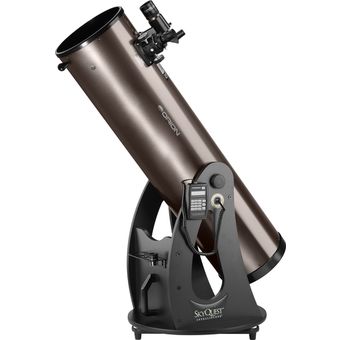
Image Credit: Orion (Used with Permission)
Orion’s “IntelliScope” Dobsonian makes it super easy to find objects in the sky – but you still get the “point and view” experience of finding objects in the sky manually.
This telescope (based on the popular Orion SkyQuest XT10) is a classic Dobsonian but it adds Orion’s innovative computer-assisted location technology. It’s not a full “go to” telescope (see below if you’re interested in that). Instead, it gives you precise “up/down” and “left/right” guidance instructions in real-time to tell you exactly where to point the telescope.
In our opinion, this is a great way to use computerized technology in a Dobsonian telescope. It doesn’t do the work for you… but it makes it a lot easier to find things!
8. Orion SkyQuest XT10G 10135 Computerized GoTo Dobsonian Telescope
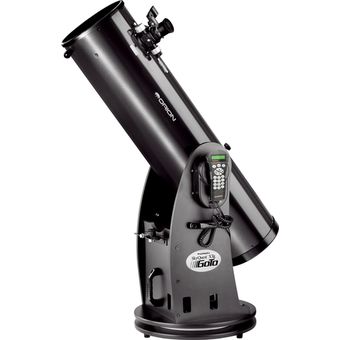
Image Credit: Orion (Used with Permission)
For the full “go to” computerized Dobsonian experience, the Orion SkyQuest XT10G offers a fully motorized system. The XT10G can automatically find more than 40,000 celestial targets. And, it will automatically track your targets as they drift across the sky. So you won’t need to continually “nudge” the telescope to keep things in the eyepiece.
If you’re looking for a large aperture plus full computerized capability – you can really maximize your bang for the buck by going with a Dobsonian-based telescope. The overall price point for such a powerful computerized telescope is really difficult to beat without the cost advantages that come with the Dobsonian design. And it’s easy to assemble, because the XT10G base comes pre-installed with the necessary motors, gears, and encoders.
Buying Guide For Dobsonian Telescopes
If you’re relatively new to telescopes, this section is for you. We’ll explain some of the key considerations and benefits of the Dobsonian telescope design. And, we’ll talk about some of the tradeoffs you’ll need to think about as you’re picking out the right telescope for your needs.
Aperture is King
For any telescope, the size of the aperture is arguably the most important element to consider. For Dobsonian telescopes, the aperture refers to the size of the primary parabolic mirror. The light enters the telescope and bounces off this mirror, then it bounces off the secondary mirror before going through the eyepiece so you can view the image.
The larger the primary mirror, the more light can be collected by the telescope. And, the more light collected, the more detail available for you to view. A larger mirror translates directly into brighter images with better resolution (so you can make out details in distant galaxies and nebula that would be impossible with less light collection).
Additionally, a larger aperture allows you to “zoom in” better. Have you ever tried to zoom in on a low-resolution picture? It’s the same with a telescope. The larger the aperture, the less “grainy” your magnified images – so you can see far great detail when magnified with larger aperture telescopes. And you can use additional eyepieces to further magnify the image coming from the primary mirror.
Bottom line: When choosing a Dobsonian telescope, a good rule of thumb is to try to get the largest aperture that fits within (a) your budget, and (b) your vehicle. Be careful not to buy a telescope that’s so big and bulky that you’ll never use it. Go for something you can afford and something you can easily transport and set up at your preferred viewing location. For a lot of people, 6-8″ is a good “sweet spot” size.
Why Dobsonian Telescopes Use the Newtonian Reflector Design
Newtonian reflectors are used in Dobsonian telescopes primarily because they are (a) affordable, and (b) simple.
First, they are affordable – because a mirror-based (reflector) telescope costs a lot less money compared to refractor telescopes that use a glass lens as their primary light-gathering component. Reflector telescopes are available at a fraction of the price compared to high-quality refractor telescopes in the same aperture size.
Second, they are simple – Newtonian telescopes are built with just two mirrors. There is the primary parabolic mirror used to collect the light, and then there is a secondary mirror to redirect the light to the eyepiece. That’s it. Just two mirrors to calibrate (collimate) for a perfectly aligned image.
On the other hand, other kinds of mirror-based telescopes (compound or catadioptric, e.g. Schmidt-Cassegrain and other similar types) use more than two mirrors, which makes them more complex and also more expensive.
Focal Length (a.k.a. Focal Distance)
One key consideration in a Dobsonian telescope is the focal distance (or focal length, which is the same thing).
If you see a Dobsonian that looks long and narrow, it probably has a longer focal distance. (For example, the XT8, our #1 recommendation in this article, has a 1200mm focal distance.) A Dobsonian that appears “shorter and fatter” probably has a shorter focal distance. (For example, the Zhumell Z130 has a 650mm focal length – making it much more compact.)
There are several tradeoffs here – and there is no single right answer.
The first tradeoff relates to how much “zoom” you have in your telescope. A short focal distance gives you a wider field of view (which is great for viewing larger nebulae, star clusters, or sections of the sky). A longer focal distance gives you a narrower field of view, and you can apply higher magnification to “zoom in more” on your target (which is great for getting close-up details of planets and viewing other smaller targets in greater detail).
The other tradeoff is with the size of the telescope. A shorter focal distance will give you a more compact telescope, while a longer focal distance will naturally make your Dob longer, for any given aperture size.
Ease of Use: The Magic is in the Dobsonian Base
Instead of adjustable tripods and sophisticated mounting technology, Dobsonian telescopes are spartan in comparison. The alt-azimuth mount is made up of parts you could buy in your local hardware store. There is nothing fancy about the Dobsonian base mount.
And that’s what makes it so compelling.
The classic Dobsonian base/mount has two key elements:
- A rotating base that sits on the ground. This is the “azimuth” axis, and it rotates to adjust the horizontal direction of the telescope.
- A dual-arm fork or rocker box which holds the telescope. This is the “alt” (altitude) axis. It allows the telescope to move up and down along its vertical axis.
That’s it, really. It’s drop-dead simple.
To move a Dobsonian telescope, you don’t need to fiddle around with various knobs and slow-motion controls. Instead, you just nudge the telescope in the direction you want to point. Center your target in the finder-scope, and then (like magic) you are ready to look through the eyepiece.
The huge advantage to the Dobsonian base is how easy it makes it for you to find things in the sky. Astronomy is fun when you are able to jump around easily and look at anything you want to see.
The biggest downside is that you’ll have to manually track objects as they drift across the sky. (And you would be surprised how quickly this happens.) This can become a challenge if you’re looking to spend a lot of time looking at one particular target, or if you’re looking to do some long-exposure astrophotography with your telescope.
Portability and Ease of Setup
The other big advantage of the Dobsonian base is that you can assemble or disassemble the telescope in a matter of seconds. (This statement does not apply to the larger collapsible models. Those require a bit more time each time you need to set it up and take it down.)
The main tube separates from the base, and you can easily transport both pieces in your vehicle. You can take it camping, or set it up in your backyard and then bring it back inside later in the evening. Or you can bring it with you to a dark-sky viewing location and enjoy an immensely rewarding viewing experience.
While Dobsonian telescopes are not always super lightweight, the portability and transportability are still fairly good. But keep in mind, it’s not a traveling telescope. You’ll need a vehicle and perhaps a couple pairs of strong hands to move it into position each time.
Frequently Asked Questions (FAQ) for Best Dobsonian Telescope
What Are The Advantages Of A Dobsonian Telescope?
Dobsonian telescopes are a great choice for getting started with astronomy and making your budget stretch as far as possible. Here are the top 3 reasons to choose a Dobsonian for a first telescope:
- Affordability. Dobsonian telescopes offer the best possible aperture vs. cost ratio compared to any other type of telescope. It uses mirrors instead of more expensive lenses, and the mount is made using low-cost components. If your #1 priority is to see the brightest and most detailed images possible within your budget, then this is the telescope to beat.
- Easy to point and view, “grab and go” telescope. With its unique, floor-based, friction-balanced Alt-Az mount design, you don’t need to fiddle with knobs and controls to point the telescope in the direction of whatever you want to look at. You simply point the telescope where you want to look, check the finder scope, and then look through the eyepiece. For this reason, Dobsonian telescopes are a lot of fun and super easy to use.
- Learning the skies. If you love astronomy and you want to get a lot of experience navigating the sky manually, this is a great option. You can quickly and easily set it up in your backyard or take it with you to a dark-sky location, and you’ll learn how to “star hop” and find various targets in the sky.
How Did the Dobsonian Telescope Get Its Name?
The Dobsonian design is named after John Dobson, who is widely credited for his revolutionary approach using low-cost construction techniques to create telescopes. John Dobson introduced the Dobsonian base coupled with the Newtonian reflector optical design, and the rest is history.
Dobson is also well known for his outreach to the general public through the San Francisco Sidewalk Astronomers. You can read more about him here: https://en.wikipedia.org/wiki/John_Dobson_(amateur_astronomer).
Can I Use My Dobsonian Telescopes For Astrophotography?
Yes, Dobsonian-style telescopes can be used for short-exposure astrophotography, especially for planets and the Moon. However, they are not suitable for long-exposure imaging because the mount is not designed for smooth tracking and autoguiding.
What Can I See Using A Dobsonian-Style Telescope?
Dobsonian-style telescopes give you a lot of flexibility to view a variety of things in the sky. Within the solar system, you’ll be able to see the moon in wonderful detail, plus you can zoom in on the planets. Jupiter and Saturn (in particular) are gorgeous with a decent-sized aperture Dobsonian.
With the 6″ to 8″ (or larger) Dobsonians, you’ll start to be able to see more distant targets in the sky beyond our solar system. These include globular clusters, open clusters, nebulae, and even some galaxies.
How Large Should My Telescope Be To View Saturn?
Any of the Dobsonian telescopes in this article should be able to give you a great view of Saturn’s rings. With a minimum magnification of 25x you’ll be able to see the rings clearly. At higher magnification you’ll be able to distinguish details within the rings or even view the Cassini division.
To calculate the magnification of your telescope, simply divide the focal distance of the telescope by the focal distance of the eyepiece. (So, for example, a 1200mm telescope with a 5mm eyepiece will give you 240x magnification.)
What Are The Best Brands Of Dobsonian Telescope?
The leading brands making Dobsonian telescopes for the general market are Orion, Sky-Watcher, and Zhumell. In this article we feature recommendations from all of these quality brands. You’ll also find some great Dobsonian options from Meade, Explore Scientific, and Apertura.
Conclusion – Best Dobsonian Telescope
Hopefully we’ve convinced you in this article to consider going with a Dobsonian if you’re shopping for a first telescope. The affordability and practicality are really hard to beat with any other type of telescope.
And we hope our recommendations were helpful to you in deciding which Dobsonian brand/model is the right fit for your needs. Now it’s your turn to pick one out and take your interest in astronomy to the next level.
Happy stargazing!
(Also, if you liked this article, please share it using the social media buttons below!)








